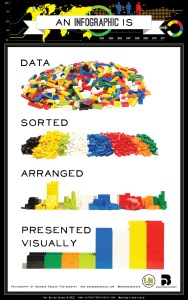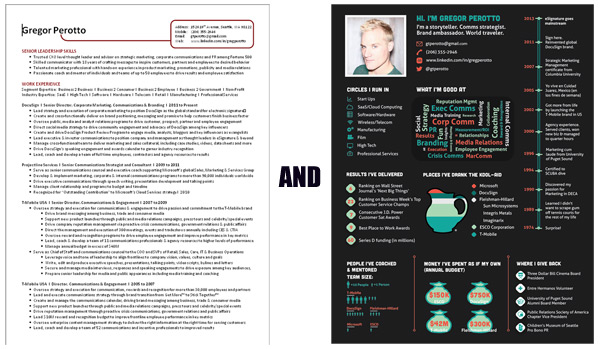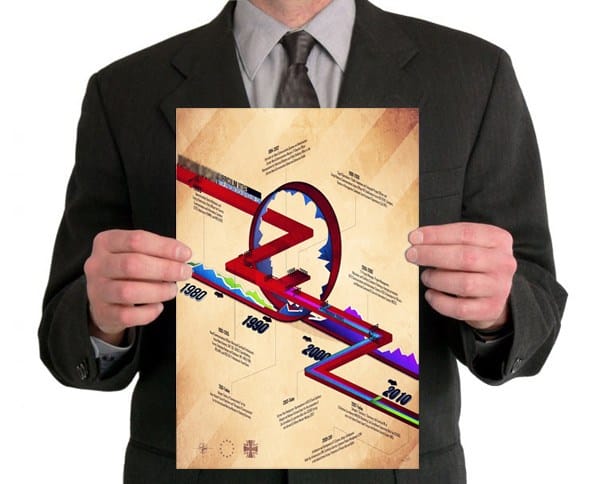A great infographic uses those images to tell a story and inspire you to share that story with others.
The magic of infographics can even make your resume more engaging, which is just what you need to get noticed in a competitive job market.
Remember: a resume is a marketing document designed to engage the hiring manager, get you the interview, and eventually land you the job.
An infographic resume can help you get more positive attention, but only if you know what you’re doing.
“An infographic resume is a great way to stand out from the crowd,” says Lauren Ferrara, a creative recruiter for Creative Circle, a staffing firm that specializes in advertising and creative staffing. “Recruiters and hiring managers review hundreds of resumes on a daily basis and if you can find a way to differentiate yourself, you should take that opportunity.”
Do you need an infographic resume or is this just another hyped-up trend? We talked to dozens of candidates, recruiters, and hiring managers about infographic resumes.
Read on for our advice on using this job search and networking tool to your advantage.
The Basics: What Is An Infographic Resume?
What exactly do we mean by infographic? I like Techopedia’s definition:

The last part of the definition is key. The goal of an infographic is not just to look cool – it is to help viewers quickly engage with the material and understand the main points. The goal of a resume is also to engage the reader and tell your story quickly.
Let’s face it: your resume will only have a few seconds to win over that busy hiring manager.
However, in order to get results, an infographic resume must be designed well and used thoughtfully. There are pros and cons to using an infographic resume during your job search.
Infographic Resumes: The Pros
First, let’s take a look at some of the potential benefits of using an infographic resume:
1. Stand out from the crowd
Lauren Ferrara at Creative Circle recruits for some of the top advertising agencies in the world. The competition for these jobs is fierce and she believes that a cleverly-designed infographic resume can get you the attention of the right people.
Jobseeker Bryan Lovgren has also seen what an infographic resume can do. “I’ve had people tell me they almost hired me on the spot because of my creative resume,” says Lovgren, Digital Marketing Manager for Skyrocket Media. “I created it to inject more of my personality and make my experience more consumable by recruiters and hiring agencies.”
2. Demonstrate your creativity and talent
“The infographic resume is also a great way to show your creativity, design sensibility, and personality,” says recruiter Lauren Ferrara. Her clients are looking for creative people and the infographic resume becomes another work sample.
However, the infographic resume is not only for advertising creatives and graphic designers. A clever infographic resume can also demonstrate other strengths — including your marketing and branding expertise, your writing skills, your presentation savvy, and/or your knowledge of social media trends.
As Senior Director of Corporate Marketing at DocuSign, Gregor Perotto hires for marketing positions and believes that infographic resumes can help marketers stand out in a crowded field. “I haven’t seen many infographic resumes come across my desk – which is surprising. Perhaps marketers face the same challenge as the cobbler whose children have no shoes. They aren’t taking the time to sell their own skills because they are so focused on selling their companies’ products and services to others.”
Perotto also practices what he preaches and uses an infographic resume as a networking tool.

3. Take control of telling your story
The infographic resume is not just an opportunity to show off your cleverness. You should be using your cleverness to tell a compelling story about yourself. A picture is supposed to be worth a thousand words, right? Use the power of visuals to communicate what’s special about you.
“A digital resume gives you so much more freedom and creative flexibility to tell your story,” says Perotto of DocuSign. “You can take your experiences and make them visually appealing and unique to you through graphics.”
With an infographic resume, you’re not constricted by the same format that everyone else is using. You can put the emphasis on the information that shows you are the best person for the job.
4. Be a better networker
An infographic resume can also be a very effective networking tool. Share it with a new contact and it becomes a conversation starter. Make it something that people want to pass along.
In fact, some professionals are opting to use infographics to create a cool online bio to use primarily for networking – and sticking with something more traditional when formally submitting a resume. Todd Silverstein is the co-founder of Vizify, a company that helps people create graphical bios to present their personal brands online.
“Originally, we thought about using the Vizify technology to programmatize the infographic resume,” says Silverstein. However, after conducting research and testing with recruiters in late 2011, Silverstein and his team found that infographic resumes provided an edge only in creative fields such as marketing, advertising and design. Note: Read on in the Cons section for more about this finding.
On the other hand, they found that a compelling visual bio had uses beyond the standard resume function. “We were hearing that the graphical bio became really important after the sort down to 10 candidates who all looked good,” says Silverstein. The Vizify profile is really more of a networking tool, a way of presenting your personal brand online (though some Vizify members do use their bio as infographic resumes).
Infographic Resumes: The Cons
1. Not right for every industry/role
The traditional resume has been THE way to do it for a long time. Hiring managers know how to quickly scan and categorize traditional resumes. Many are not interested in changing the way that they work.
Meanwhile, some professions and companies are more conservative than others. To someone with a conservative perspective, an infographic resume can make the applicant look frivolous or downright wacky.
“Creative industries and positions respond really well to infographic resumes—for example, communications, marketing, advertising, PR, etc.,” says Bryan Lovgren. “Industries like finance don’t respond as well. There’s an industry standard for what a resume should look like and what should be contained therein. They want professional and professional to them is black and white with paragraphs meticulously edited to their standards.”
2. A bad version makes a bad impression
It’s not easy to design a compelling infographic resume. If you can’t do it well yourself, get some help or don’t do it at all.
3. Not accepted for some job applications
If you’re applying online, you may be limited to a standard set of fields and formatting options. An infographic resume won’t work well in these situations. You’ll need a traditional resume to comply with some employers’ requirements.
The bottom line: An infographic resume can’t completely replace your traditional resume. You will still need a strong traditional resume for certain situations. The infographic resume just gives you another tool to use when the situation calls for something more creative.
Infographic Resumes That Stand Out (in a Good Way)
Try a Combination Approach:
“What I’ve noticed through my network is that more and more marketing/adverting/sales professionals are creating hybrid resumes like mine. First part infographic, second part (work history) traditional. This seems to capture the attention of HR while allowing them to read through the resume like a traditional one.”– Anton Dobrosevic, senior marketing manager.
Make It Visually Compelling:
“To create a compelling infographic, use as little text as possible, and instead make your points more visual. The information conveyed should be fresh, creative, and interesting, and the design must be clean and captivating – unless you’re an experienced designer, you may want to hire a professional to design your infographic.” – Andrew Schrage, Head of Hiring at Money Crashers, the online financial publication.
Keep It Simple
“One word of caution. Don’t go over the top with the graphics! Your resume should still be succinct and easy to read.” — Lauren Ferrara, recruiter for Creative Circle.
Infographic Resume Features
Here are some features commonly used in infographic resumes:
- Timeline – Infographic resumes often use a visual timeline to show employment history, key achievements, and career milestones.
- Quotes/References – You can feature testimonials and quotes from current and former managers, clients, or colleagues. You can also quote press mentions and other positive buzz about you. These are strong credibility builders.
- Photo – People respond to photos. If you’ve got a good one (professional and flattering and conveying the right image), use it.
- Headline/Tagline – Use a headline format to summarize who you are. You can focus solely on the professional or add a bit of personality.
An example from David P. Ingram (see below) uses: “I make the design and delivery of great software happen.”
Perotto’s says: “I’m a storyteller. Comms strategist. Brand ambassador. World traveler.”
-
- Statistics – Find a way to depict your strengths in numbers. Options include number of years of experience, number of successful projects, percentage of client satisfaction, etc.
- Logos – If you’ve worked for top companies, display their logos. Employers respond to this kind of name dropping. You can support your own credibility with the credibility of well-known brands. You can also feature logos of media outlets that have featured you, organizations that have honored you, causes that you support, etc.
- Tag cloud – Several people recommended the use of a tag cloud visual to represent skills, areas of expertise, personality qualities, and/or strengths.
Infographic Resumes Made Easy
Even if you’re not a design genius, you can still make a lovely infographic resume. There are a number of online tools that help non-designers quickly create their own infographics.
1. Vizify– Vizify allows you to transform your social media profiles/content into a graphical bio highlighting the best parts of your professional and personal story. Vizify can also instantly generate an “animated portrait of your Twitter account.”
2. Vizualize-me– Vizualize.me lets you automatically create a visual resume based on your LinkedIn information.
3. LinkedIn — In May, LinkedIn announced new tools to visually enhance your LinkedIn profile.
4. Re-vu – Re-vu is another tool that creates a visual resume in a few easy steps.
5. Infogr.am – This tool allows non-designers to quickly generate infographics from any data (for a resume or any other purpose).
Get Noticed with Your Own Infographic Resume
If you work in a creative field or creativity is one of your strengths, you should seriously consider designing an infographic resume. Even if you’re in a more conservative field, infographics can help you network more effectively by making your online presence more compelling.
While the infographic resume won’t completely replace the traditional resume any time soon, it can be a valuable tool to help you build your network and get more interviews.
If you have experience with infographic resumes (from either a candidate’s or hiring manager’s perspective), we’d love to hear your thoughts.
